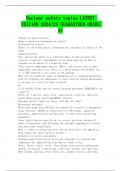Nuclear safety topics LATEST
EDITION 2024/25 GUARANTEED GRADE
A+
Purpose of plant barriers
Helps to maintain configuration control.
Configuration control
Refers to the design basis, documentation, and physical layout of the
plant
Impaired barrier
This can put the plant in a situation where it may not meet the
station's technical requirements or the plant may not be able to
respond (as designed) to a negative event
Plant barrier impairment permits (PBIs), and entries into a plant
impairment controlled log. There is a third method (CC-AA-201), but
it is NOT required to be a part of the package.
What are two different types of documentation or tracking mechanisms
used for tracking the impairment of plant barriers during maintenance
or as part of a test? Is there a third?
No
Is CC-AA-201 (Plant barrier control program procedure) REQUIRED to be
a part of
There are 7 barrier types: Fire, ventilation, security, radiation,
flood, High energy line break(HELB), Missile
How many barrier types are there, and what are they?
Maintenace personnel
Which work group does NOT have the authority to modify or manipulate
plant barriers, EXCEPT as authorized by a PBI permit, approved
procedure, approved work instructions, or equivelant controlling
documents?
Every safety barrier must be in its correct position, during all
modes of operation, and following the suitable compensatory actions
that have been established.
When it comes to safety barriers, how do they need to be upheld to
help ensure the plant operates safety?
Corporate or station procedures
Guidance and clarification of actions necessary to evaluate and
compensate for impaired barriers may be found in the:
Doors, floors, walls, roofs, floor plugs, penetrations and gypsum
boards, structural fireproofing, electrical raceway fire barriers,
HVAC plenum, ducting, floor drain sets, manhole covers, and berms.
, The point is that barriers are just some form of blockade or barrier
to entry.
ASIDE from the 7 barrier types, what may also be considered barriers?
Both a security barrier and a fire barrier
A door entering into the emergency diesel generator room may function
as:
Both fire and flood barriers
Water tight doors installed below grade can function as:
True
Barriers can provide multiple functions that may not always be
obvious, meaning some of our barriers can be considered multiple
barrier types (the 7 types)
Compensatory actions must either be installed or be able to be
installed, within the time they would be expected to function
If a barrier protected event were to occur, then:
Immediately reported to operations management or designated personnel
Unauthorized impairments must be:
PBI permit or equivelant controls
Barriers that provide no design bases function, do NOT require:
In regards to fire protection systems, t's important to note that
impairment of a barrier or associated compensatory actions may affect
the operability of a gaseous fire suppression system. For example,
propping open a fire door in the diesel generator room may prohibit
the carbon dioxide fire deluge system from extinguishing a fire in
the room. Safety considerations should be given to protecting any
item running through a door, such as electrical or welding cables and
air or water hoses.
Fire protection systems may not always be covered by the plant
barrier requirements, HOWEVER:
True. The amount of time the door can be held open depends on the
applicable procedures. It also may require notification to the
security department, if it is a monitored door.
Fire doors may be held open without a PBI permit during normal
operations.
The impacts and compensatory actions are acceptable. compensatory
actions must be in place and they must have verified that current
plant conditions allow the barrier to be impaired.
If a work group wants to impair a barrier (to gain access to the area
or equipment), operations will sign and date the controlling
documents when they have verified that:
timeclock
Some barriers are tied to action statement time requirements (we must
complete this within x amt of time.) This is sometimes referred to as
a:




